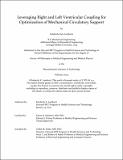Leveraging Right and Left Ventricular Coupling for Optimization of Mechanical Circulatory Support
Author(s)
Lamberti, Kimberly Kate
DownloadThesis PDF (3.780Mb)
Advisor
Edelman, Elazer R.
Terms of use
Metadata
Show full item recordAbstract
Mechanical circulatory support devices have the potential for profound impact on cardiogenic shock patients. They enable volume propulsion and pressure gradient generation first by unloading and later by decoupling native cardio-vascular interactions, which reduces cardiac load and energy consumption while increasing organ perfusion in the face of disease. However, there is a potential price in that coupling evolved to optimize blood flow dynamics and the complex interplay between individual cardiovascular components and interposing organs like the lung. Disrupting native coupling with mechanical support risks decompensation if the heart and lung cannot tolerate these changes.
One particularly concerning consequence of altered coupling is that upwards of 40% of patients with left-sided mechanical support face ensuing right heart failure, which requires urgent action and often is associated with even higher mortality rates. We hypothesized that better understanding of right heart function and the mechanisms of right heart (in)tolerance to left-sided support will improve device utility by aiding device selection as well as titration throughout a patient’s clinical course. In particular, we focused on right and left ventricular coupling, which consists of serial coupling across the closed-loop cardiovascular circuit, and parallel coupling that enables intracardiac interdependence and force transmission between the ventricles. Each interaction plays a critical role in a patient’s tolerance to mechanical support and optimal setpoint.
We used a series of controlled porcine experiments to evaluate right and left heart coupling during mechanical support. In each set of experiments, we induced graded models of disease that range from health to progressive impairment, enabling evaluation of mechanical support across a spectrum of right and left heart states. Through these studies, we improved mechanistic understanding of the differences between right and left heart function, and how those differences dictate the response to left-sided support. Specifically, we found that pulmonary vascular compliance enabled a unique right heart adaptability to varied flow, but limitations in compliance due to disease yield right heart intolerance to support. We leveraged the indwelling pump to dynamically alter load in the system, creating a method to rapidly evaluate pulmonary vascular compliance adaptability and therefore predict the need for right-sided support. Finally, we created a metric using device-organ interactions for tracking right-left coupling over time, which can aid optimization of device speed based on relative right and left ventricular volume setpoints. Translation of these findings to the clinic could better inform use of mechanical circulatory support technologies with the goal of improving outcomes for cardiogenic shock patients.
Date issued
2025-02Department
Harvard-MIT Program in Health Sciences and TechnologyPublisher
Massachusetts Institute of Technology